Silver Nanoparticle Chains for Ultra-Long-Range Plasmonic Waveguides for Nd3+ Fluorescence
Abstract
1. Introduction
2. Materials and Methods
2.1. Sample Preparation
2.2. Optical Characterization
2.3. Numerical Calculations
3. Results and Discussion
4. Summary and Conclusions
Supplementary Materials
Author Contributions
Funding
Data Availability Statement
Conflicts of Interest
References
- Väkeväinen, A.I.; Moerland, R.J.; Rekola, H.T.; Eskelinen, A.-P.; Martikainen, J.-P.; Kim, D.-H.; Törmä, P. Plasmonic Surface Lattice Resonances at the Strong Coupling Regime. Nano Lett. 2014, 14, 1721–1727. [Google Scholar] [CrossRef]
- Bodetti, A.K.; Guan, J.; Sentz, T.; Juarez, X.; Newman, W.; Cortes, C.; Odom, T.W.; Jacob, Z. Long-Range Dipole−Dipole Interactions in a Plasmonic Lattice. Nano Lett. 2022, 22, 22–28. [Google Scholar] [CrossRef]
- Azzam, S.I.; Kildishev, A.V.; Ma, R.-M.; Ning, C.-Z.; Oulton, R.; Shalaev, V.M.; Stockman, M.I.; Xu, J.-L.; Zang, X. Ten years of spases and plasmonic nanolasers. Light Sci. Appl. 2020, 9, 90. [Google Scholar] [CrossRef]
- Ma, R.-M.; Oulton, R.F. Applications of nanolasers. Nat. Nanotech. 2019, 14, 12–22. [Google Scholar] [CrossRef]
- Molina, P.; Yraola, E.; Ramírez, M.O.; Tserkezis, C.; Plaza, J.L.; Aizpurua, J.; Bravo-Abad, J.; Bausá, L.E. Plasmon-Assisted Nd3. based Solid-State Nanolaser. Nano Lett. 2016, 16, 895–899. [Google Scholar] [CrossRef]
- Fernández-Bravo, A.; Wang, D.; Barnard, E.S.; Teitelboim, A.; Tajon, C.; Guan, J.; Schatz, G.C.; Cohen, B.E.; Chan, E.M.; Schuck, P.J.; et al. Ultralow-threshold, continuous-wave upconverting lasing from subwavelength plasmons. Nat. Mater. 2019, 18, 1172–1176. [Google Scholar] [CrossRef]
- Fang, Y.; Sun, M. Nanoplasmonic waveguides: Towards applications in integrated nanophotonic circuits. Light Sci. Appl. 2015, 4, e294. [Google Scholar] [CrossRef]
- Gather, M.C.; Meerolz, K.; Leosson, K. Net optical gain in a plasmonic waveguide embedded in a fluorescent polymer. Nat. Photonics 2010, 4, 457–461. [Google Scholar] [CrossRef]
- Ditlbacher, H.; Hohenau, A.; Wagner, D.; Kreibig, U.; Rogers, M.; Hofer, F.; Aussenegg, F.R.; Krenn, J.R. Silver Nanowires as Surface Plasmon Resonators. Phys. Rev. Lett. 2005, 95, 257403. [Google Scholar] [CrossRef]
- Wang, W.; Yang, Q.; Fan, F.; Xu, H.; Wang, Z.L. Light Propagation in Curved Nanowire Plasmonic Waveguides. Nano Lett. 2011, 11, 1603–1608. [Google Scholar] [CrossRef]
- Prymaczek, A.; Cwierzona, M.; Grzelak, J.; Kowalska, D.; Nyk, M.; Mackowski, S.; Piatkowski, D. Remote activation and detection of up-converted luminescence via surface plasmon polaritons propagating in a silver nanowire. Nanoscale 2018, 10, 12841–12847. [Google Scholar] [CrossRef]
- Maier, S.A.; Kik, P.G.; Atwater, H.A. Optical pulse propagation in metal nanoparticle chain waveguides. Phys. Rev. B 2003, 67, 205402. [Google Scholar] [CrossRef]
- Maier, S.A.; Kik, P.G.; Atwater, H.A.; Meltzer, S.; Harel, E.; Koel, B.E.; Requicha, A.G. Local detection of electromagnetic energy transport below the diffraction limit in metal nanoparticle plasmon waveguides. Nat Mater. 2003, 2, 229–232. [Google Scholar] [CrossRef]
- Mayer, M.; Potapov, P.L.; Pohl, D.; Steiner, A.M.; Schultz, J.; Rellinghaus, B.; Lubk, A.; König, T.A.F.; Fery, A. Direct Observation of Plasmon Band Formation and Delocalization in Quasi-Infinite Nanoparticle Chains. Nano Lett. 2019, 19, 3854–3862. [Google Scholar] [CrossRef]
- Solis, D., Jr.; Willingham, B.; Nauert, S.K.; Slaughter, L.S.; Olson, J.; Swanglap, P.; Paul, A.; Chang, W.-S.; Link, S. Electromagnetic Energy Transport in Nanoparticle Chains via Dark Plasmon Modes. Nano Lett. 2012, 12, 1349–1353. [Google Scholar] [CrossRef]
- Gür, F.N.; McPolin, C.P.T.; Raza, S.; Mayer, M.; Roth, D.J.; Steiner, A.M.; Löffler, M.; Fery, A.; Brongersma, M.K.; Zayats, A.V.; et al. DNA-Assembled Plasmonic Waveguides for Nanoscale Light Propagation to a Fluorescent Nanodiamond. Nano Lett. 2018, 18, 7323–7329. [Google Scholar] [CrossRef]
- Bergman, D.J.; Stockman, M.I. Surface Plasmon Amplification by Stimulated Emission of Radiation: Quantum Generation of Coherent Surface Plasmons in Nanosystems. Phys. Rev. Lett. 2003, 90, 027402. [Google Scholar] [CrossRef]
- De Leon, I.; Berini, P. Amplification of long-range surface plasmons by a dipolar gain medium. Nat. Photonics 2010, 4, 382–387. [Google Scholar] [CrossRef]
- Grandidier, J.; Colas des Francs, G.; Massenot, S.; Bouhelier, A.; Markey, L.; Weeber, J.-C.; Finot, C.; Dereux, A. Gain-Assisted Propagation in a Plasmonic Waveguide at Telecom Wavelength. Nano Lett. 2009, 9, 2935–2939. [Google Scholar] [CrossRef] [PubMed]
- Citrin, D.S. Plasmon-polariton transport in metal-nanoparticle chains embedded in a gain medium. Opt. Lett. 2006, 31, 98–100. [Google Scholar] [CrossRef]
- Zhang, H.; Ho, H.-P. Low-loss plasmonic waveguide based on gain-assisted periodic metal nanosphere chains. Opt. Express 2010, 18, 23035–23040. [Google Scholar] [CrossRef] [PubMed]
- Udagedara, I.B.; Rukhlenko, I.D.; Premaratne, M. Surface-plasmon-polariton propagation in piecewise linear chains of composite nanospheres: The role of optical gain and chain layout. Opt. Express 2011, 19, 19973–19986. [Google Scholar] [CrossRef] [PubMed]
- Solis, D., Jr.; Paul, A.; Olson, J.; Slaughter, L.S.; Swanglap, P.; Chang, W.-S.; Link, S. Turning the Corner: Efficient Energy Transfer in Bent Plasmonic Nanoparticle Chain Waveguides. Nano Lett. 2013, 13, 4779–4784. [Google Scholar] [CrossRef] [PubMed]
- Suarez, I.; Ferrando, A.; Marques-Hueso, J.; Díez, A.; Abargues, R.; Rodríguez-Cantó, P.J.; Martínez-Pastor, J.P. Propagation length enhancement of surface plasmon polaritons in gold-/micro-waveguides by the interference with photonic modes in the surrounding active dielectrics. Nanophotonics 2017, 6, 1109–1120. [Google Scholar] [CrossRef]
- Klinkova, A.; Choueiri, R.M.; Kumacheva, E. Self-assembled plasmonic nanostructure. Chem. Soc. Rev. 2014, 43, 3976–3991. [Google Scholar] [CrossRef]
- Barabanenkov, M.Y.; Italyantsev, A.G.; Sapegin, A.A. Comparative Study of Light Guiding by Freestanding Linear Chains of Spherical Au and Si Nanoparticles. Phys. Status Solidi B 2020, 257, 2000151. [Google Scholar] [CrossRef]
- Schletz, D.; Schultz, J.; Potapov, P.L.; Steiner, A.M.; Krehl, J.; König, T.A.F.; Mayer, M.; Lubk, A.; Fery, A. Exploiting Combinatorics to Investigate Plasmonic Properties in Heterogeneous Ag-Au Nanosphere Chain Assemblies. Adv. Opt. Mater. 2021, 9, 2001983. [Google Scholar] [CrossRef]
- Negoro, H.; Sugimoto, H.; Hinamoto, T.; Fujii, M. Template-Assisted Self-Assembly of Colloidal Silicon Nanoparticles for All-Dielectric Nanoantenna. Adv. Opt. Mater. 2022, 10, 2102750. [Google Scholar] [CrossRef]
- Fan, X.; Walther, A. 1D Colloidal Chains: Recent Progress from Formation to Emergent Properties and Applications. Chem. Soc. Rev. 2022, 51, 4023–4074. [Google Scholar] [CrossRef]
- Zhong, T.; Kindem, J.M.; Miyazono, E.; Faraon, A. Nanophotonic Coherent Light–Matter Interfaces Based on Rare-Earth-Doped Crystals. Nat. Commun. 2015, 6, 8206. [Google Scholar] [CrossRef]
- Zhong, T.; Kindem, J.M.; Bartholomew, J.G.; Rochman, J.; Craiciu, I.; Miyazono, E.; Bettinelli, M.; Cavallii, E.; Verma, V.; Nam, S.W.; et al. Nanophotonic rare-earth quantum memory with optically controlled retrieval. Science 2017, 357, 1392–1395. [Google Scholar] [CrossRef]
- Serrano, D.; Karlsson, J.; Fossati, A.; Ferrier, A.; Goldner, P. All-optical control of long-lived nuclear spins in rare-earth doped nanoparticles. Nat. Commun. 2018, 9, 2127. [Google Scholar] [CrossRef]
- Bermúdez, V.; Serrano, M.D.; Diéguez, E. Bulk periodic lithium niobate crystals doped with Er and Yb. J. Cryst. Growth 1999, 200, 185–190. [Google Scholar] [CrossRef]
- Kalinin, S.V.; Bonnell, D.A.; Alvarez, T.; Lei, X.; Hu, Z.; Shao, R.; Ferris, J.H. Ferroelectric Lithography of Multicomponent Nanostructures. Adv. Mater. 2004, 16, 795–799. [Google Scholar] [CrossRef]
- Sun, Y.; Eller, B.S.; Nemanich, R.J. Photo-induced Ag deposition on periodically poled lithium niobate: Concentration and intensity dependence. J. Appl. Phys. 2011, 110, 084303. [Google Scholar] [CrossRef]
- Molina, P.; Yraola, E.; Ramírez, M.O.; Plaza, J.L.; de las Heras, C.; Bausá, L.E. Selective Plasmon Enhancement of the 1.08 μm Nd3+ Laser Stark Transition by Tailoring Ag Nanoparticles Chains on a PPLN Y-cut. Nano Lett. 2013, 13, 4931–4936. [Google Scholar] [CrossRef]
- Yraola, E.; Molina, P.; Plaza, J.L.; Ramírez, M.O.; Bausá, L.E. Spontaneous emission and nonlinear response enhancement by silver nanoparticles in a Nd3+ doped periodically poled LiNbO3 laser crystal. Adv. Mater. 2013, 25, 910–915. [Google Scholar] [CrossRef]
- Yraola, E.; Sánchez-García, L.; Tserkezis, C.; Molina, P.; Ramírez, M.O.; Plaza, J.L.; Aizpurua, J.; Bausá, L.E. Controlling solid state gain media by deposition of silver nanoparticles: From thermally-quenched to plasmon-enhanced Nd3+ luminescence. Opt. Express 2015, 23, 15670. [Google Scholar] [CrossRef]
- Yraola, E.; Sánchez-García, L.; Tserkezis, C.; Molina, P.; Ramírez, M.O.; Aizpurua, J.; Bausá, L.E. Polarization-selective enhancement of Nd3+ photoluminescence assisted by linear chains of silver nanoparticles. J. Lumin. 2016, 169, 569–573. [Google Scholar] [CrossRef]
- Huber, G.; Kränkel, C.; Petermann, K. Solid-state lasers: Status and future. J. Opt. Soc. Am. B 2010, 27, B93–B105. [Google Scholar] [CrossRef]
- Bünzli, J.C.G. Lanthanide luminescence for biomedical analyses and imaging. Chem. Rev. 2010, 110, 2729–2755. [Google Scholar] [CrossRef]
- Nam, S.H.; Bae, Y.M.; Park, Y.I.; Kim, J.H.; Kim, H.M.; Choi, J.S.; Lee, K.T.; Hyeon, T.; Suh, Y.S. Long-term real-time tracking of lanthanide ion doped upconverting nanoparticles in living cells. Angew. Chem. Int. 2011, 50, 6093. [Google Scholar] [CrossRef]
- Serrano, D.; Kuppusamy, S.K.; Heinrich, B.; Fuhr, O.; Hunger, D.; Ruben, M.; Goldner, P. Ultra-narrow optical linewidths in rare-earth molecular crystals. Nature 2022, 603, 241–246. [Google Scholar] [CrossRef]
- Sánchez-García, L.; Ramírez, M.O.; Solé, R.M.; Carvajal, J.J.; Díaz, F.; Bausá, L.E. Plasmon-induced dual-wavelength operation in a Yb3+ laser. Light Sci. Appl. 2019, 8, 14. [Google Scholar] [CrossRef]
- Fernández-Martínez, J.; Carretero-Palacios, S.; Sánchez-García, L.; Bravo-Abad, J.; Molina, P.; van Hoof, N.; Ramírez, M.O.; Gómez Rivas, J.; Bausá, L.E. Spatial coherence from Nd3+ quantum emitters mediated by a plasmonic chain. Opt. Express 2021, 29, 26244–26254. [Google Scholar] [CrossRef]
- Kalinin, S.V.; Bonnell, D.A. Local potential and polarization screening on ferroelectric surfaces. Phys. Rev. B 2001, 63, 125411. [Google Scholar] [CrossRef]
- Huang, C.-h.; McCaughan, L. Er-diffused Ti:LiNbO3 channel waveguide optical amplifiers pumped at 980 nm. Electron. Lett. 1996, 32, 215–216. [Google Scholar] [CrossRef]
- Cantelar, E.; Torchia, G.A.; Sanz-García, J.A.; Pernas, P.L.; Lifante, G.; Cussó, F. Tm3+-Doped Zn-Diffused LiNbO3 Channel Waveguides. Phys. Scr. 2005, T118, 69–71. [Google Scholar] [CrossRef]
- Salas-Montiel, R.; Solmaz, M.E.; Eknoyan, O.; Madsen, C.K. Er-Doped Optical Waveguide Amplifiers in X-Cut Lithium Niobate by Selective Codiffusion. IEEE Photonics Technol. Lett. 2010, 22, 362–364. [Google Scholar] [CrossRef]
- Cantelar, E.; Lifante, G.; Cussó, F.; Domenech, M.; Busacca, A.; Cino, A.; Riva Sanseverino, S. Dual-polarization-pump CW laser operation in Nd3+:LiNbO3 channel waveguides fabricated by reverse proton exchange. Opt. Mater. 2008, 30, 1039–1043. [Google Scholar] [CrossRef]
- Lifante, G.; Cussó, F.; Jaque, F.; Sanz-García, J.A.; Monteil, A.; Varrel, B.; Boulon, G.; García-Solé, J. Site-selective spectroscopy of Nd3+ in LiNbO3:Nd and LiNbO3:Nd, Mg crystals. Chem. Phys. Lett. 1991, 176, 482–488. [Google Scholar] [CrossRef]
- Burlot, R.; Moncorge, R.; Manaa, H.; Boulon, G.; Guyot, Y.; Sole, J.G.; Cochet, M.D. Spectroscopic investigation of Nd3+ ion in LiNbO3, MgO:LiNbO3 and LiTaO3 single crystals relevant for laser applications. Opt. Mater. 1996, 6, 313–330. [Google Scholar] [CrossRef]
- Dieke, G.H.; Crosswhite, H.M. The Spectra of the Doubly and Triply Ionized Rare Earths. Appl. Opt. 1963, 2, 6745–6786. [Google Scholar] [CrossRef]
- Ramírez, M.O.; Molina, P.; Gómez-Tornero, A.; Hernández-Pinilla, D.; Sánchez-García, L.; Carretero-Palacios, S.; Bausá, L.E. Hybrid Plasmonic-Ferroelectric Architectures for Lasing and SHG Processes at the Nanoscale. Adv. Mater. 2019, 31, 1901428. [Google Scholar] [CrossRef]
- Hernández-Pinilla, D.; Molina, P.; de las Heras, C.; Bravo-Abad, J.; Bausá, L.E.; Ramírez, M.O. Multiline Operation from a Single Plasmon-Assisted Laser. ACS Photonics 2018, 5, 406–412. [Google Scholar] [CrossRef]
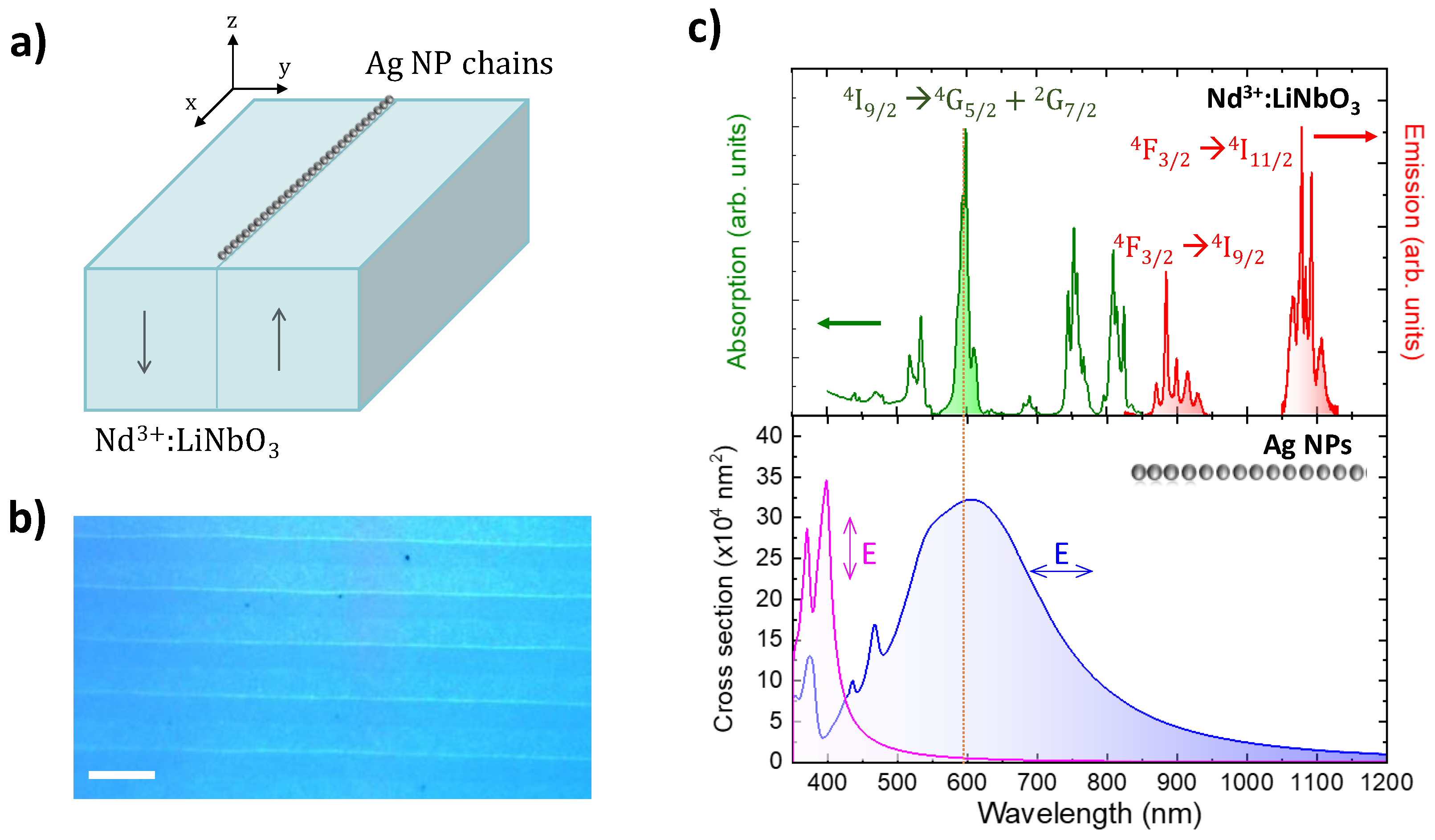
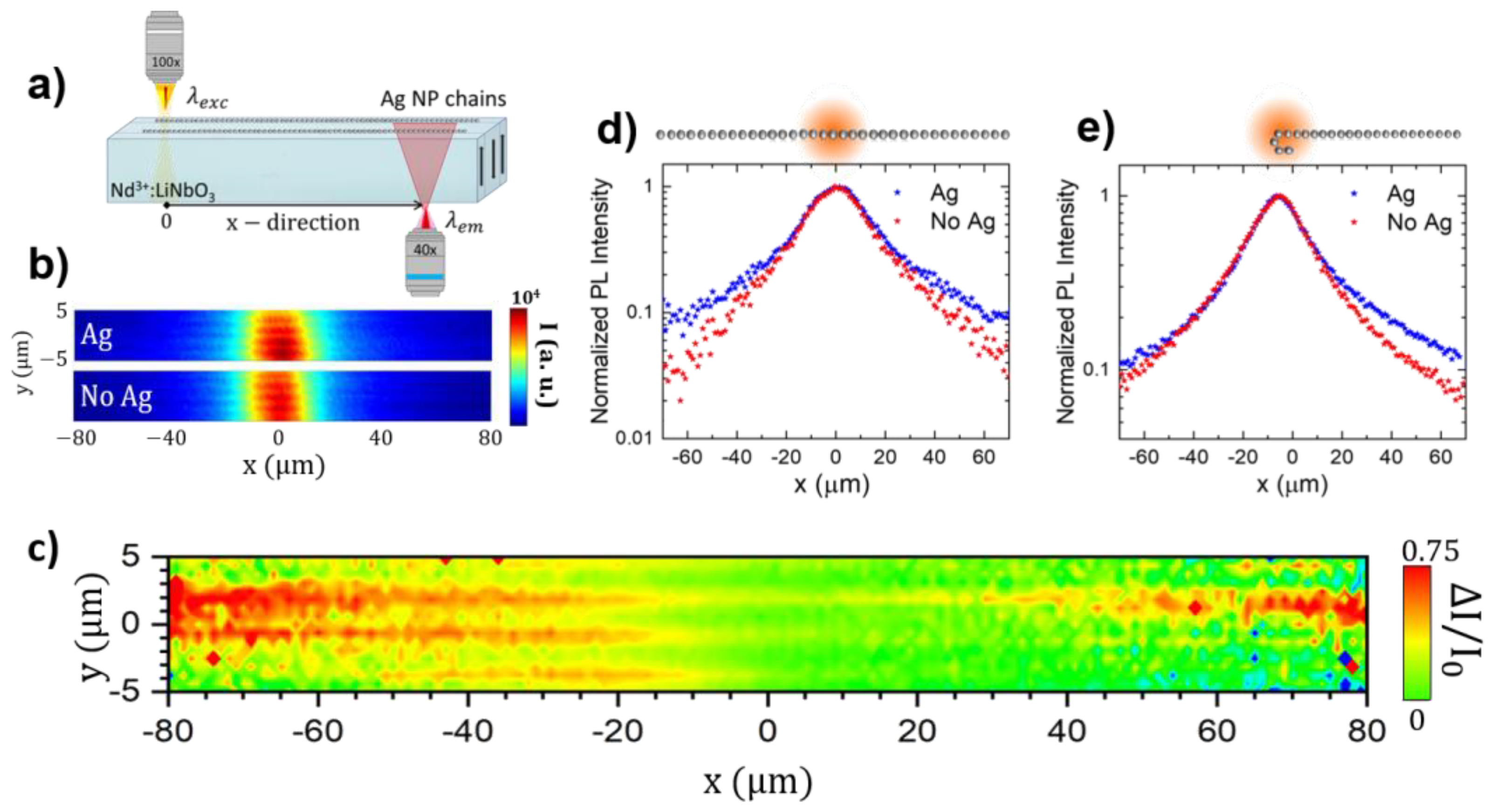
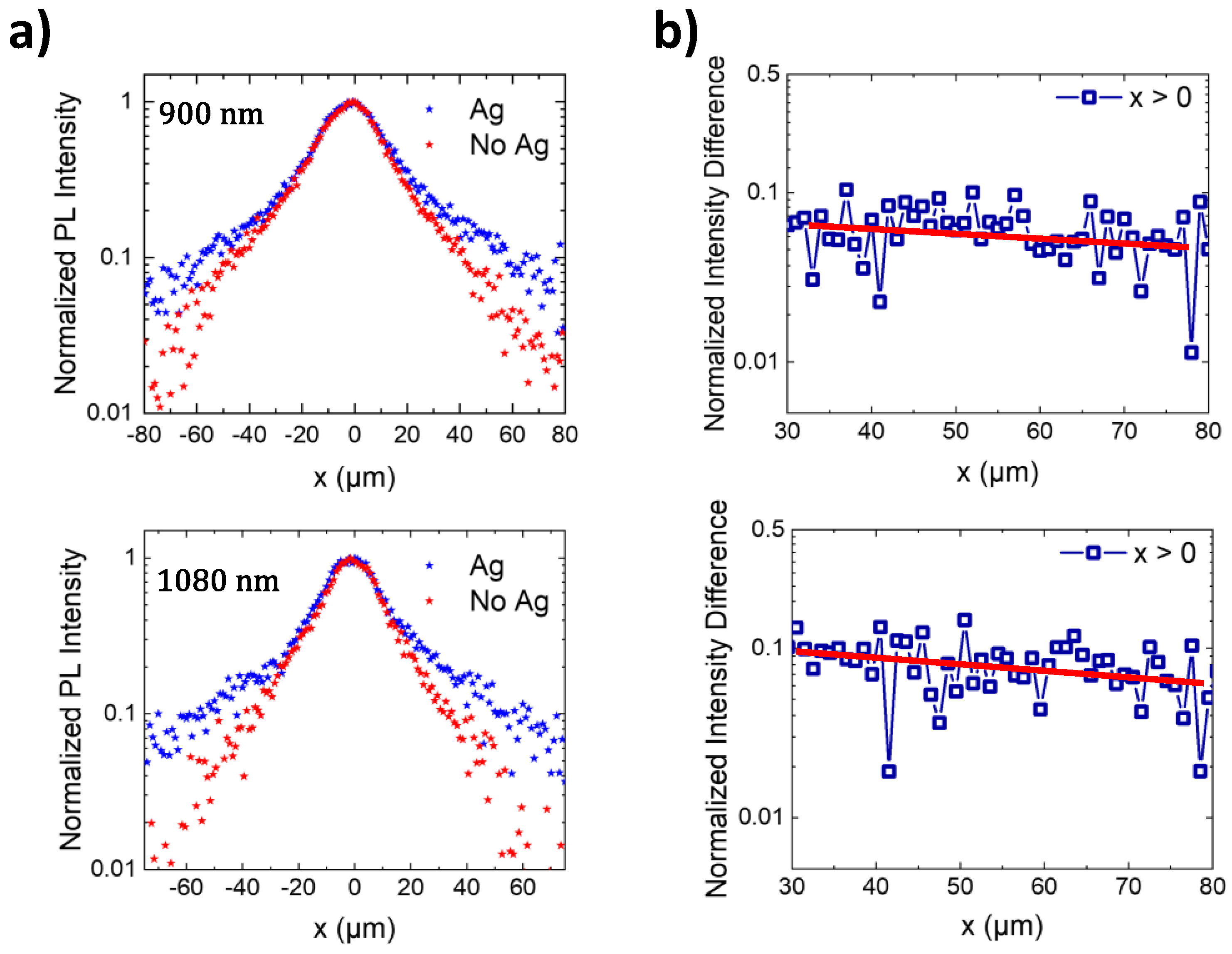
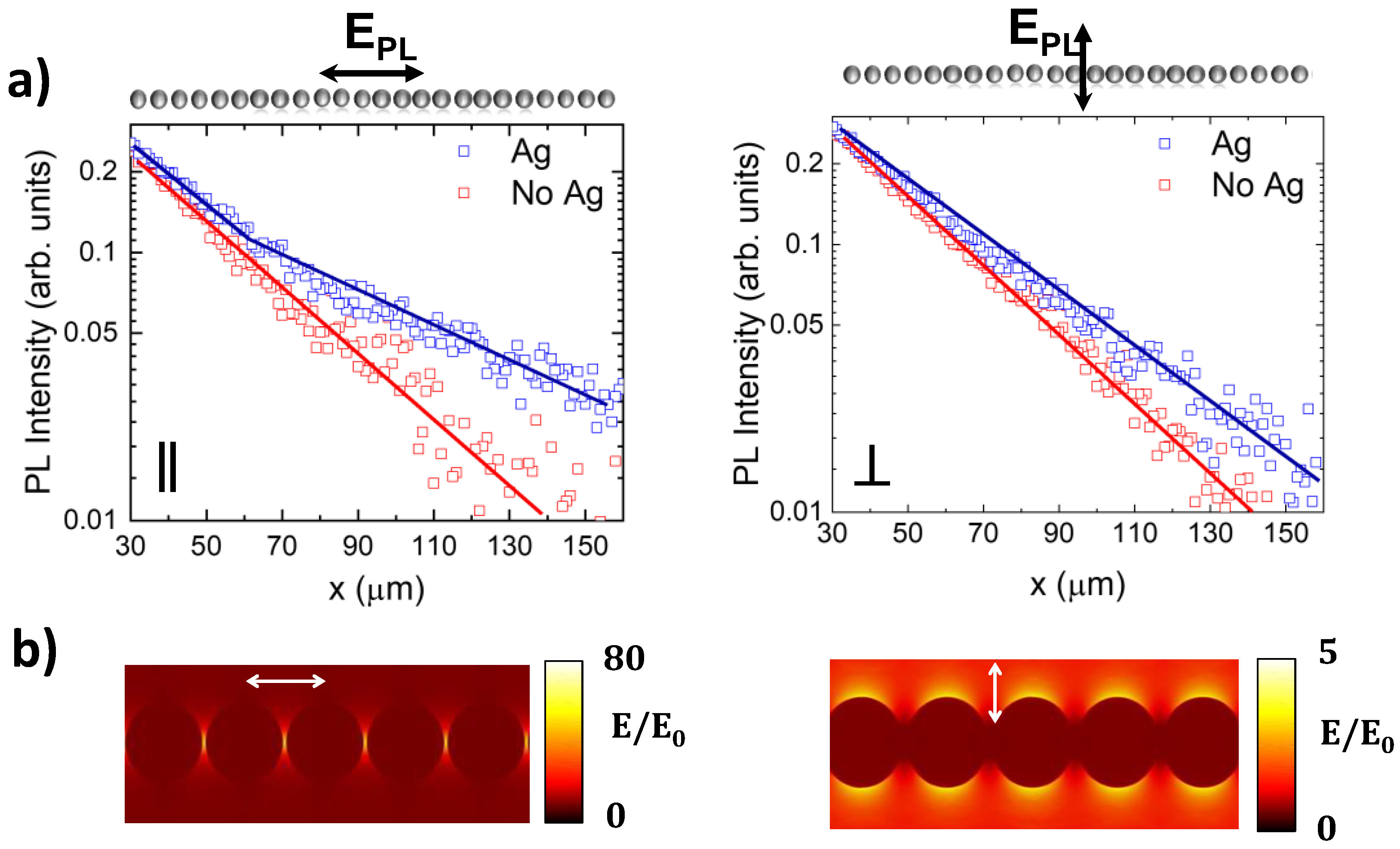
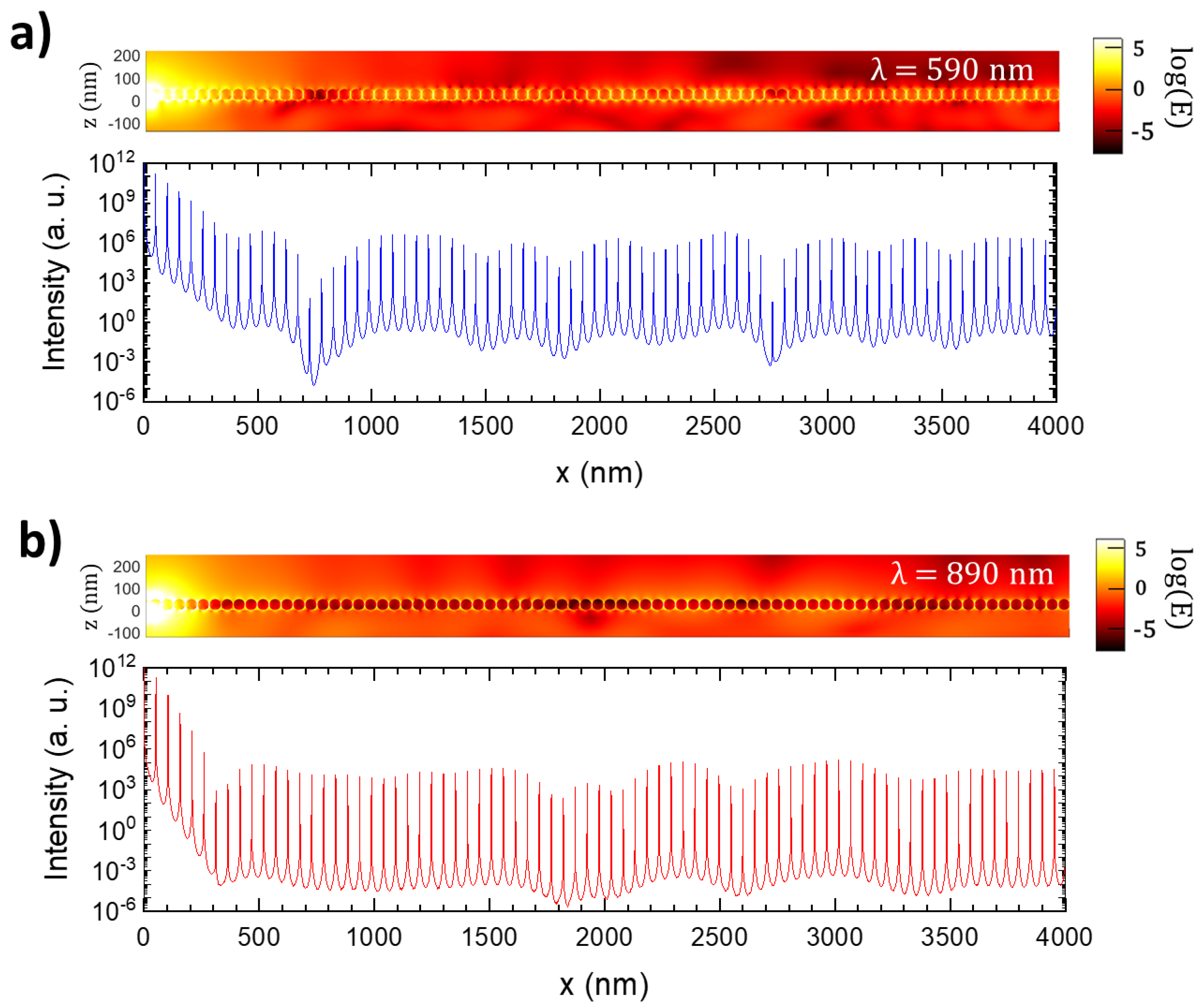
Publisher’s Note: MDPI stays neutral with regard to jurisdictional claims in published maps and institutional affiliations. |
© 2022 by the authors. Licensee MDPI, Basel, Switzerland. This article is an open access article distributed under the terms and conditions of the Creative Commons Attribution (CC BY) license (https://creativecommons.org/licenses/by/4.0/).
Share and Cite
Fernández-Martínez, J.; Carretero-Palacios, S.; Molina, P.; Bravo-Abad, J.; Ramírez, M.O.; Bausá, L.E. Silver Nanoparticle Chains for Ultra-Long-Range Plasmonic Waveguides for Nd3+ Fluorescence. Nanomaterials 2022, 12, 4296. https://doi.org/10.3390/nano12234296
Fernández-Martínez J, Carretero-Palacios S, Molina P, Bravo-Abad J, Ramírez MO, Bausá LE. Silver Nanoparticle Chains for Ultra-Long-Range Plasmonic Waveguides for Nd3+ Fluorescence. Nanomaterials. 2022; 12(23):4296. https://doi.org/10.3390/nano12234296
Chicago/Turabian StyleFernández-Martínez, Javier, Sol Carretero-Palacios, Pablo Molina, Jorge Bravo-Abad, Mariola O. Ramírez, and Luisa E. Bausá. 2022. "Silver Nanoparticle Chains for Ultra-Long-Range Plasmonic Waveguides for Nd3+ Fluorescence" Nanomaterials 12, no. 23: 4296. https://doi.org/10.3390/nano12234296
APA StyleFernández-Martínez, J., Carretero-Palacios, S., Molina, P., Bravo-Abad, J., Ramírez, M. O., & Bausá, L. E. (2022). Silver Nanoparticle Chains for Ultra-Long-Range Plasmonic Waveguides for Nd3+ Fluorescence. Nanomaterials, 12(23), 4296. https://doi.org/10.3390/nano12234296





